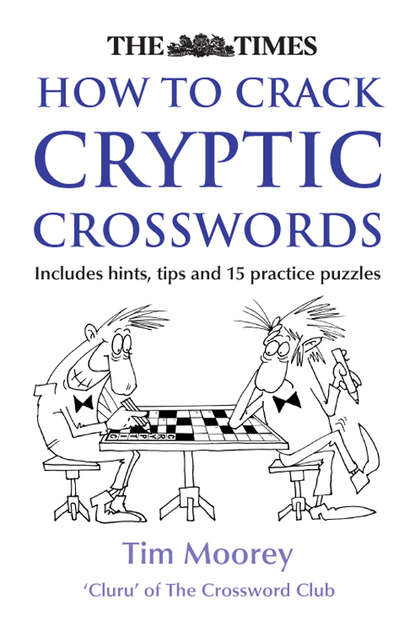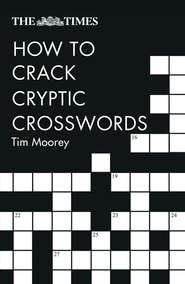По всем вопросам обращайтесь на: info@litportal.ru
(©) 2003-2024.
✖
The Times How to Crack Cryptic Crosswords
Настройки чтения
Размер шрифта
Высота строк
Поля
Next is an example in which the definition is the final word in the clue and in which the linkword is in, the sense being that the wordplay is seen in the solution. This is a trickier clue than we have seen so far, as the solution tea service is split into two parts, teaser and vice, to form the wordplay.
Puzzle failing in China (3, 7)
As well as linkwords between definition and wordplay, there can also be similar linkage within the wordplay to connect its different parts. Here it is and, a simple additive indication. The other linkword is indicates that the definition can be formed from the wordplay.
ADDITIVE CLUE: What babies need is sleep and food (7)
You will notice that the last of the example clues is labelled additive. In fact all so far have been of this type, a relatively plain construction of A + B = C which we shall consider later in more detail as one of the twelve clue types, dividing these into one group of eight and one group of four. Why split clues into two groups? Because some always contain the means of identifying their type (the first eight) and others virtually always do not (the remaining four). This distinction is amplified in the section which follows.
Indicators
At this point, beginners tend to say:
‘Yes, I know that there are different types of clue but how on earth do I know which is which?’
The answer is as follows. For the first group of eight there is always a signpost to the solution, called the indicator, within the clue sentence. Remember, an indicator is the means of identifying clue types. In Chapter 3 (#uad6b2df8-933b-5385-9c6c-eb49490558be) we will consider the specific indicators for the first group of eight clue types. In the example the indicator is wrong, showing that this is an anagram clue. The concept behind this indicator is that the letters to be mixed are incorrect and must be changed to form the solution. There are many ways of giving the same anagram instruction to solvers, as you will also see in Chapter 3 (#uad6b2df8-933b-5385-9c6c-eb49490558be).
ANAGRAM CLUE: President saw nothing wrong (10)
For the remaining group of four, it’s usually a case of informed guesswork rather than indicators. This may seem unreasonable and impossible for the novice solver but I aim to prove that this is not really the case.
In the meantime, this may be a good time to point out that trial and error and/or inspired guesswork are part and parcel of good solving. This is reinforced by the clueing practice of all good setters whereby the clue type will nearly always become clear on working backwards from the solutions. Indeed, when a solver sees the solution the following day, he or she should only rarely be left thinking (as Ximenes put it):
‘I thought of that but I couldn’t see how it could be right.’
We will now proceed to examine in detail all clue types and their indicators, with one and sometimes two examples of each type.
3: Clue Types and Indicators in Detail (#ulink_8d7beeff-812b-5af7-862c-62fe6dd86455)
‘Give us a kind of clue.’ W.S. Gilbert, Utopia Limited
Until Chapter 8 (#litres_trial_promo), we’ll keep it simple with regard to clue types. In later chapters we will see that the clue types can and often do overlap, involving more than one sort of manipulation of letters or words within any one clue.
The first eight clue types
We will now examine each of the eight clue types in detail, together with their indicators, and offer some example clues. To give yourself solving practice, you may wish from now on to cover up the bottom half of the diagram that contains the solution and wordplay.
The first eight types are shown in the circular chart below, and we shall take each in turn, working clockwise from the top.
1. The anagram clue
An anagram, sometimes termed a letter mix, is a rearrangement of letters or words within the clue sentence to form the solution word or words.
The letters to be mixed (the anagram fodder) may or may not include an abbreviation, a routine trick for old hands but, as I have observed, a cause of some discomfort for first-timers.
ANAGRAM CLUE: Mum, listen for a change (6)
This next example is an anagram clue with a linkword:
ANAGRAM CLUE: Fish and chips cooked with lard (9)
The third example is one wherein the anagram fodder goes well with the definition to form a believable whole:
ANAGRAM CLUE: The new stadium designed for a football club (4,3,6)
For is a linkword here in the sense that the wordplay is to be arranged for the answer. The essential point for indicators of anagram clues is that they show a rearrangement, a disturbance to the natural order or a change to be made. There are very many ways of doing this, some reasonably straightforward but others requiring a stretch of the imagination. For example, words and phrases related to drunkenness and madness have to be taken as involving disturbance so that stoned, pickled, tight, bananas, nuts, crackers and out to lunch could all be misleading ways to indicate an anagram. I am often asked for a comprehensive list but, because there are so many, unfortunately there is no such list. The table that follows on the next page is designed to expand on the various categories of rearrangement by giving a few examples of each overleaf:
TOP TIP - ANAGRAMS
Early crosswords did not indicate an anagram; solvers were required to guess that a mixture of letters was needed. This is universally regarded as unfair on the solver so that there will always nowadays be an indication of an anagram.
2. The sandwich clue
A sandwich can be considered as bread outside some filling. Similarly in this clue type, the solution can be built from one part being either put outside another part or being put inside another part.
This is an example of outside (with an abbreviation to be made in wordplay):
SANDWICH CLUE: Simple mug holding one litre (6)
This is an example of inside with a clear instruction as to what’s to be done:
SANDWICH CLUE: Family member put us in the money (6)
Note that about has multiple uses in crosswords (see Chapter 10 (#litres_trial_promo)).
3. The homophone clue
In this type, the solution sounds like another word given by the wordplay. The clue is often fairly easy to recognize but it may be harder to find the two words which sound alike.
HOMOPHONE CLUE: Reportedly makes pots (4)
Indicators for homophone clues:
Anything which gives an impression of sounding like another word such as so to speak, we hear, it’s said acts as an indicator. This extends to what’s heard in different real-life situations; for example, at home it could be on the radio; in the theatre it could be to an audience; in the office it could be for an auditor.
4. The hidden clue
A hidden clue is arguably the easiest type to solve. That’s because the letters to be uncovered require no change: they just need to be dug out of the sentence designed to conceal them. In the first example, the indicator is in:
HIDDEN CLUE: Parched in the Kalahari desert (4)
Indicators for hidden clues:
Commonly some (in the sense of a certain part of what follows), some of, partly, are unique to hidden clues; within, amidst, holding and in can be either hidden or sandwich indicators.
A variant of the hidden clue is where the letters are concealed at intervals within the wordplay, most commonly odd or even letters. You are asked to extract letters that appear as, say, the first, third and fifth letters in the wordplay section of the clue sentence and ignore the intervening letters. Note that there would not normally be superfluous words in such a clue sentence, making it easier to be certain which letters are involved in the extraction.
Here is one such clue in which you have to take only the odd letters of culture for the solution.






